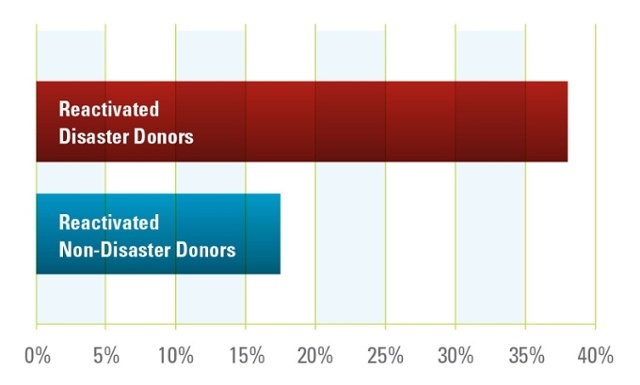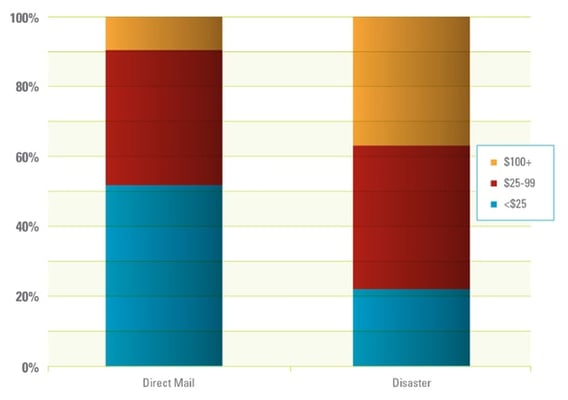
Three Myths About Salvation Army Disaster Fundraising
Disaster Donors Respond... to More Than Just Disasters
Disaster fundraising for The Salvation Army is a world unto itself. It doesn’t follow the usual rules and expectations of everyday fundraising. So it’s not surprising that some durable myths have grown out of the successes and failures inthis unique arena.
The fact is that disaster fundraising isn’t the hit-or-miss proposition that it might appear to be. Disaster donors can be acquired, and they can be cultivated. In doing so, you can expand your donor-support base and create another stream of income for your organization.
What’s more, sending disaster appeals reinforces the brand of The Salvation Army, and communicates to donors that The Salvation Army is actively engaged in helping others at a time when compassion and caring are often critical.
Here we’ll address the three myths of disaster fundraising, and debunk them with documented, case-history results.
Myth No. 1: Sending Disaster Appeals Will Sink Your Retention of Non-Disaster Donors
There’s a perception out there that sending disaster appeals will cause a drop in the retention of the non-disaster donors who receive them. Another perception is that sending disaster appeals will cause substitutional giving, meaning regular donors who give to disaster appeals will fail to give to other, non-disaster appeals. Fortunately, neither is the case.
When we looked at donor-retention data, we found that overall donor retention and the percentage of donors giving non-disaster gifts ran on roughly the same track — as we would expect. But what’s important here is that the disaster giving did not interfere with that retention. We saw that disaster giving was up in 2007 and 2008, and then in 2010 and 2011, and still the retention of regular non-donors remained unaffected.
Disaster appeals are effective at enlarging donors’ giving portfolios, and when donors are giving through more avenues, they tend to increase their long-term value, which means greater and more sustained funding for the nonprofit.
It’s clear that sending disaster appeals — whether for local, national, or international disasters — does not detract from non-disaster giving. In fact, for many donors, disaster giving becomes another way to give.
Myth No. 2: You Can’t Reactivate Lapsed Donors with Disaster Appeals
Conventional wisdom says that disasters aren’t good opportunities for reactivating lapsed donors, and that only established donors should be approached, because they’re already familiar with the nonprofit and its work.
While there may be a grain of truth in these sentiments, a large disaster creates its own reality when it comes to fundraising. Our analysis shows two conclusions. The first is that, of course, new donors can be acquired through disaster fundraising. The second is that it’s a rich opportunity for reactivating lapsed donors.
In both cases, though, speed is essential. Disaster fundraising appeals — whether mail or email — must reach donors as quickly as possible, and certainly while the disaster is still receiving news coverage. Otherwise, donors will turn their attention elsewhere.
In addition, since many donors visit a charity’s website before giving through the mail, and since many donors prefer to donate online, it’s important to make your website easy to navigate, so donors can easily see how to give.
| Chart 1: Donor Reactivation from Disaster Fundraising |
 |
Disasters often motivate lapsed donors to resume giving. |
As Chart 1 shows, disaster fundraising is highly effective for reactivating lapsed donors. Over 35 percent of all reactivated donors were motivated to give again after receiving a disaster appeal, while just a little over 15 percent of reactivated donors were motivated by a non-disaster, lapsed donor appeal. It’s clear that disaster appeals work extremely well at prompting lapsed disaster donors to give again.
As we’ve seen, you will acquire new donors via a disaster, but you also have the opportunity to reactivate donors. Even more importantly, though, you can cultivate these donors to become regular supporters of your organization.
Myth No. 3: Donors Who Give to Disasters Don’t Generate Any Real Value
If you ask many fundraisers, they’ll tell you that most donors who give to disasters are giving small, impulse gifts. Our analysis found just the opposite.
As Chart 2 shows, disaster donors gave higher-value gifts than typical direct mail donors. For example, compared with traditional direct mail donors, there was a higher percentage of disaster donors in the $25 to $99 segment — about 3 percent higher. But even more significantly, there was a dramatic 27 percent increase in the $100+ segment over that of typical direct mail donors. Clearly, donors who give to disasters are responding with greater levels of generosity than typical direct mail donors.
Disaster donors are high-value donors. A percentage of these donors will convert to become regular supporters, and those donors in the higher-dollar segments are well worth cultivating, because their larger initial gifts mean that they represent a greater long-term value.
| Chart 2: Disaster Donors Are High-Value Donors |
 |
Disaster fundraising is especially effective at motivating $100+ donors. |
Obviously the conventional wisdom is wrong. With disaster fundraising, you can keep your donor retention high, you can reactivate lapsed donors, and you can generate real value.
By understanding the strategies and tactics that are unique to disaster fundraising, nonprofits can reach donors who are motivated to give to disasters and cultivate those donors so they continue giving, all while providing other support to the organization. The nonprofit, the donor, and the disaster survivors all win.
